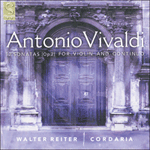Sonata I, in G minor, establishes right at the start the nature of the collaboration between the treble and bass parts. The first, second and fourth movements employ the contrapuntal device of imitation with an almost academic ostentation, while the third movement (Sarabanda) pursues a quite different path, bringing the cello into prominence by giving it a highly active accompanying line in regular quavers. These alternative ways of highlighting the cello—through thematic integration with the violin or through thematic independence coupled with virtuosity—are deployed throughout the set. Perhaps the most attractive movement in this sonata is the final Corrente, which apes the traditional Giga in its extravagant, almost grotesque melodic leaps.
from notes by Michael Talbot © 2004
La
Sonata I en sol mineur asseoit d’emblée la nature de la collaboration entre les parties de soprano et de basse. Les premier, deuxième et quatrième mouvements recourent au procédé contrapuntique de l’imitation avec une ostentation quasi académique, cependant que le troisième (Sarabanda) emprunte une toute autre voie et met le violoncelle en lumière via une ligne d’accompagnement des plus actives, en croches régulières. De telles mises en valeur du violoncelle—par une combinaison thématique avec le violon ou par une indépendance thématique couplée à de la virtuosité—sont déployées dans l’ensemble du corpus. Le mouvement le plus séduisant de cette sonate est peut-être la Corrente finale, qui singe la Giga traditionnelle et ses sauts mélodiques extravagants, grotesques presque.
extrait des notes rédigées par Michael Talbot © 2004
Français: Hypérion
In
Sonata I (g-Moll) wird gleich am Anfang das zusammenwirkende Moment der Beziehung zwischen der Ober- und Unterstimme hergestellt. Im ersten, zweiten und vierten Satz wird das kontrapunktische Stilmittel der Imitation mit fast akademischer Nachdrücklichkeit eingesetzt, während der dritte Satz (Sarabanda) ein völlig anderes Ziel verfolgt: hier wird auf das Cello, das eine besonders aktive Begleitung in Achtelnoten zu spielen hat, aufmerksam gemacht. Die verschiedenen Techniken, mit denen das Cello akzentuiert wird—thematische Integration mit der Violinstimme oder thematische Unabhängigkeit gepaart mit Virtuosität—sind im gesamten Zyklus zu beobachten. Der schönste Satz dieser Sonate ist vielleicht die Corrente, die die traditionelle Giga mit ihren extravaganten, fast grotesken melodischen Sprüngen nachahmt.
aus dem Begleittext von Michael Talbot © 2004
Deutsch: Viola Scheffel


 Vivaldi: 12 Sonatas for violin and continuo Op 2
Vivaldi: 12 Sonatas for violin and continuo Op 2
